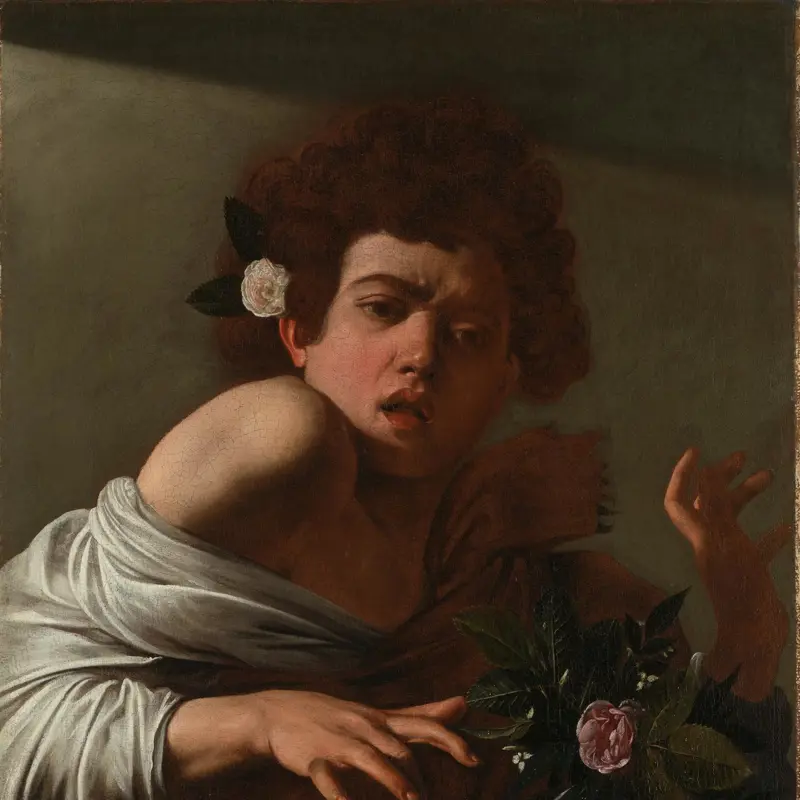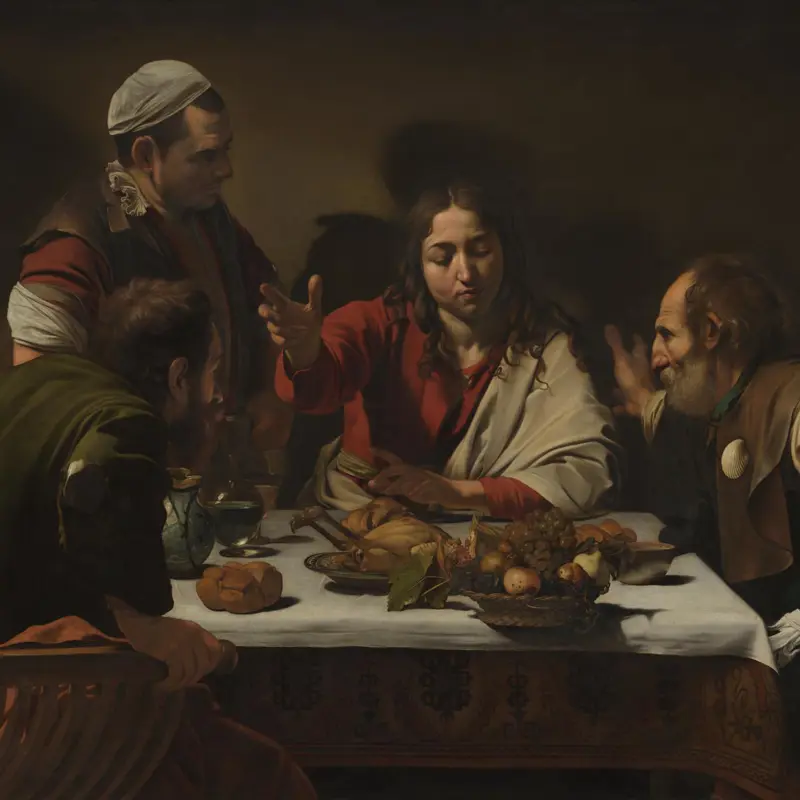Michelangelo Merisi da Caravaggio, 'Salome receives the Head of John the Baptist', about 1609-10
About the work
Overview
The story of the death of John the Baptist is related in the Gospel of Mark (6: 16–29). John had criticised King Herod for marrying his brother’s wife, Herodias, and she sought revenge. At Herod’s birthday feast, Herodias’s daughter Salome so delighted the King by her dancing that he promised her anything she wanted. Encouraged by her mother, she asked for the Baptist’s head, and the King had John executed.
This is a late work by Caravaggio, probably painted towards the end of his life. He has reduced the story to its essentials, focusing on the human tragedy and conveying the scene’s emotional power through a restricted range of colour, pronounced chiaroscuro and dramatic gesture. The brutish executioner places John’s head on a salver held by Salome, whose serious expression and sidelong glance are enigmatic. An elderly maidservant clasps her hands in grief, setting the emotional tone. Characteristic of Caravaggio’s mature works, the composition appears simple but actually hides a sophisticated physical and psychological interplay between the main protagonists.
Key facts
Details
- Full title
- Salome receives the Head of John the Baptist
- Artist dates
- 1571 - 1610
- Date made
- about 1609-10
- Medium and support
- oil on canvas
- Dimensions
- 91.5 × 106.7 cm
- Acquisition credit
- Bought, 1970
- Inventory number
- NG6389
- Location
- Room 32
- Collection
- Main Collection
- Frame
- 17th-century Spanish Frame
Provenance
Additional information
This painting is included in a list of works with incomplete provenance from 1933–1945; for more information see Whereabouts of paintings 1933–1945.
Text extracted from the ‘Provenance’ section of the catalogue entry in Michael Levey, ‘National Gallery Catalogues: The Seventeenth and Eighteenth Century Italian Schools’, London 1986; for further information, see the full catalogue entry.
Exhibition history
-
2012Bodies and Shadows: Caravaggio and His LegacyMusée Fabre23 June 2012 - 14 October 2012Los Angeles County Museum of Art11 November 2012 - 10 February 2013Wadsworth Atheneum Museum of Art8 March 2013 - 16 June 2013
-
2013Caravaggio to Canaletto: The Glory of Italian Baroque and Rococo PaintingSzépművészeti Múzeum25 October 2013 - 16 February 2014
-
2016Beyond CaravaggioThe National Gallery (London)12 October 2016 - 15 January 2017
-
2017Dentro CaravaggioPalazzo Reale (Milan)29 September 2017 - 28 January 2018
-
2019Caravaggio NapoliMuseo Nazionale di Capodimonte11 April 2019 - 14 July 2019
-
2024The Last CaravaggioThe National Gallery (London)18 April 2024 - 21 July 2024
Bibliography
-
1672G.P. Bellori, Le vite de'pittori, Rome 1672
-
1927R. Longhi, 'Un San Tomaso del Velazquez e le congiuntere italo‑spagnole tra il '5 e il '600', Vita artistica, II/1, 1927
-
1952D. Mahon, 'Addenda to Caravaggio', The Burlington Magazine, XCIV/586, 1952, pp. 2-23
-
1953R. Hinks, Michelangelo Merisi da Caravaggio: His Life, His Legend, His Works, London 1953
-
1959R. Longhi, 'Un'opera estrema del Caravaggio', Paragone, III, 1959, pp. 21‑32
-
1961R. Jullian, Caravage, Paris 1961
-
1962R. Causa, 'Luca Forte e il primo tempo della natura morta a Napoli', Paragone, CXL, 1962, pp. 41-8
-
1963L. Venturi, Caravaggio, 2nd edn, Novara 1963
-
1963B. Nicolson, 'Caravaggesques in Naples', The Burlington Magazine, CV/722, 1963, pp. 209‑10
-
1963G. Scavizzi (ed.), Caravaggio e i Caraveggeschi (exh. cat. Palazzo Reale (Naples), 10 February - 21 April 1963), Naples 1963
-
1966S. Bottari, Caravaggio, Florence 1966
-
1966R. Causa, Caravaggio, Milan 1966
-
1967A. Ottino della Chiesa, L'opera completa del Caravaggio, Milan 1967
-
1967S. Borla, 'L'ultimo percorso del Caravaggio', Antichità Viva, VI/4, 1967
-
1968R. Longhi, Ampliamento nell'Officina ferrarese, Rome 1968
-
1968M.F. Dell'Arco, 'Le opere di misericordia: Contributo alla poetica del Caravaggio', L'arte, I, 1968, pp. 37‑61
-
1969M.F. Dell'Arco, Le opere di misericordia: Contributo alla poetica del Caravaggio, London 1969
-
1969M. Kitson, The Complete Paintings of Caravaggio, London 1969
-
1969H.E. Wethey, The Paintings of Titian: The Religious Paintings, 3 vols, London 1969
-
1970M.F. Dell'Arco and M. Marini, 'Rassegna degli studi caravaggeschi 1951‑70', L'arte, 11-12, 1970, pp. 117-28
-
1970Museo del Prado, Pintura italiana del siglo XVII (exh. cat. Casón del Buen Retiro, April - May 1970), Madrid 1970
-
1971The National Gallery, The National Gallery: January 1969 - December 1970, London 1971
-
1971G.A. Dell'Acqua and M. Cinotti, Il Caravaggio e le sue grandi opere da San Luigi dei francesi, Milan 1971
-
1971M. Levey, The Seventeenth and Eighteenth Century Italian Schools, London 1971
-
1971M. Calvesi, 'Caravaggio o la ricerca della salvazione', Storia dell'arte, III/9-10, 1971, pp. 93-141
-
1971R.E. Spear, Caravaggio and his Followers (exh. cat. Cleveland Museum of Art, 29 October 1971 - 2 January 1972), Cleveland 1971
-
1972R. Causa, La pittura del Seicento a Napoli dal naturalismo al barocco: La natura morta a Napoli nel Sei e nel Settecento, Napoli 1972
-
1973M. Cinotti (ed.), Immagine del Caravaggio. Mostra didattica itinerante. Catalogo, Cinisello Balsamo 1973
-
1974M. Marini, Io Michelangelo da Caravaggio, Rome 1974
-
1974H. Röttgen, Il Caravaggio: Ricerche e interpretazioni, Rome 1974
-
1974B. Nicolson, 'Editorial: Caravaggio and His Circle in the British Isles', The Burlington Magazine, CXVI, 1974
-
1975M. Cinotti, 'Il contributo della mostra didattica itinerante "Immagine del Caravaggio"', in M. Cinotti (ed.), Novità sul Caravaggio, Milan 1975, pp. 217-50
-
1975M. Gregori, 'Significato delle mostre caravaggesche dal 1951 a oggi', in M. Cinotti (ed.), Novità sul Caravaggio, Milan 1975, pp. 27-60
-
1976G.P. Bellori, Le vite de' pittori, scultori et architetti moderni, ed. E. Borea, Turin 1976
-
1976A. Moir, Caravaggio and His Copyists, New York 1976
-
1977V. Pacelli, 'New Documents Concerning Caravaggio in Naples', The Burlington Magazine, LXIX/897, 1977, pp. 819-29
-
1978F. Bardon, Caravage: Ou, l'experience de la matière, Paris 1978
-
1978V. Pacelli, 'Caracciolo Studies', The Burlington Magazine, CXX, 1978, pp. 493‑7
-
1978V. Pacelli, 'Nuovi documenti sull'attività del Caravaggio a Napoli', Napoli nobilissima, XVII, 1978, pp. 57‑67
-
1978W. Prohaska, 'Beiträge zu Giovanni Battista Caracciolo', Jahrbuch der Kunsthistorischen Sammlungen in Wien, LXXIV, 1978, pp. 153‑269
-
1980M. Marini, Caravaggio Werkverzeichnis, trans. W. Bensch, Frankfurt am Main 1980
-
1980V. Pacelli and F. Bologna, 'Caravaggio, 1610: La Sant'Orsola sconfitta dal tiranno per Marcantonio Doria', Prospettiva, XXIII, 1980, pp. 24‑44
-
1982A. Moir, Caravaggio, New York 1982
-
1982Whitfield and J. Martineau (eds), Painting in Naples 1606-1705: From Caravaggio to Giordano (exh. cat. Royal Academy of Arts, 2 October - 12 December 1982), London 1982
-
1983M. Cinotti, Michelangelo Merisi detto il Caravaggio: Tutte le opere, Bergamo 1983
-
1983H. Hibbard, Caravaggio, London 1983
-
1984F. Campagna Cicala, 'Intorno all'attività di Caravaggio in Sicilia: Due momenti del caravaggismo siciliano: Mario Minniti e Alonzo Rodriguez', in Caravaggio in Sicilia, Syracuse 1984, pp. 101-44
-
1985Metropolitan Museum of Art, The Age of Caravaggio (exh. cat. Metropolitan Museum of Art, 5 February - 14 April 1985; Museo di Capodimonte, May - June 1985), New York 1985
-
1986Levey, Michael, National Gallery Catalogues: The Seventeenth and Eighteenth Century Italian Schools, London 1986
-
1986K. Christiansen, 'Caravaggio and "L'esempio davanti del naturale"', Art Bulletin, LXVIII/3, 1986, pp. 421‑45
-
1987M. Marini, Michelangelo Merisi da Caravaggio 'pictor praestantissimus', Rome 1987
-
1987M. Marini, 'La "Giuditta" del 1607', in M. Calvesi, L'ultimo Caravaggio e la cultura artistica a Napoli in Sicilia e a Malta, Syracuse 1987, pp. 59-80
-
1990M. Calvesi, Le realtà del Caravaggio, Turin 1990
-
1990B. Nicolson and L. Vertova, Caravaggism in Europe, 2nd edn, Turin 1990
-
1990S. Loire, La Guerchin en France (exh. cat. Musée du Louvre, 31 May 1990 -12 November 1990), Paris 1990
-
1992F. Bologna, L'incredulità del Caravaggio e l'esperienza delle 'cose naturali', Turin 1992
-
1993M. Gregori, 'Il San Giovannino alla sorgente del Caravaggio', Paragone, XXXIV, 1993, pp. 3-20
-
1994Musée des beaux arts de Strasbourg, La peinture à Naples au XVIIe siècle (exh. cat. Musées de la Ville de Strasbourg, 5 March - 23 May 1994; Musée des Beaux-Arts, 3 June -21 August 1994), Strasbourg 1994
-
1995V. Pacelli, L'ultimo Caravaggio: Dalla Maddalena a mezza figura ai due san Giovanni (1606-1610), Todi 1995
-
1996J. Held, Caravaggio: Politik und Martyrium der Körper, Berlin 1996
-
1998L. Keith, 'Three Paintings by Caravaggio', National Gallery Technical Bulletin, XIX, 1998, pp. 37‑51
-
2001
C. Baker and T. Henry, The National Gallery: Complete Illustrated Catalogue, London 2001
-
2004N. Spinosa, Caravaggio: L'ultimo tempo: 1606-1610 (Caravaggio: The Final Years) (exh. cat. Museo di Capodimonte, 23 October 2004 - 23 January 2005; The National Gallery, London, 23 February - 22 May 2005), Naples 2004
-
2005V. Sgarbi et al., Caravaggio e l'Europa: Il movimento caravaggesco internazionale da Caravaggio a Mattia Preti (exh. cat. Palazzo Reale (Milan), 15 October 2005 - 6 February 2006), Milan 2005
-
2006U. Kultermann, 'The "Dance of the Seven Veils": Salome and Erotic Culture Around 1900', Artibus et historiae, XXVII/53, 2006, pp. 187-215
About this record
If you know more about this work or have spotted an error, please contact us. Please note that exhibition histories are listed from 2009 onwards. Bibliographies may not be complete; more comprehensive information is available in the National Gallery Library.



